JVC KD-G415, KD-G416 User Manual
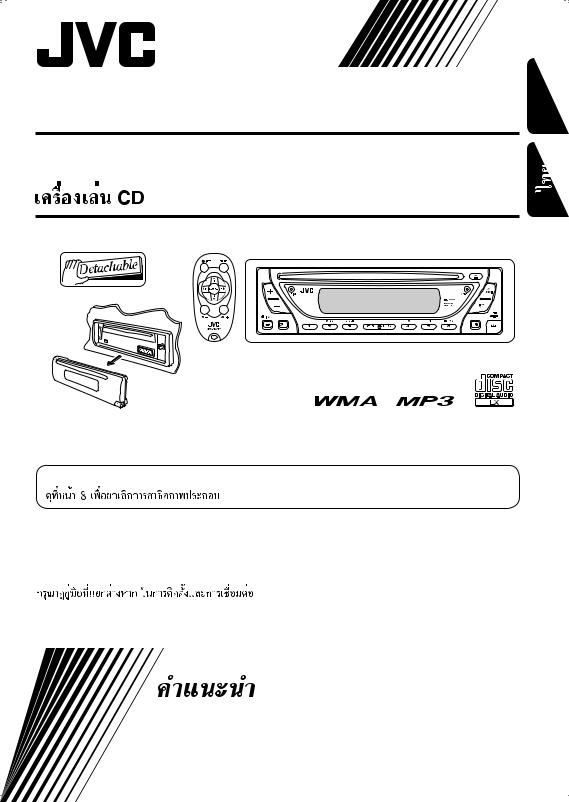
CD RECEIVER
KD-G416/KD-G415
KD-G416/KD-G415
ENGLISH
For canceling the display demonstration, see page 8.
For installation and connections, refer to the separate manual.
INSTRUCTIONS
GET0259-001A
[U/UH]
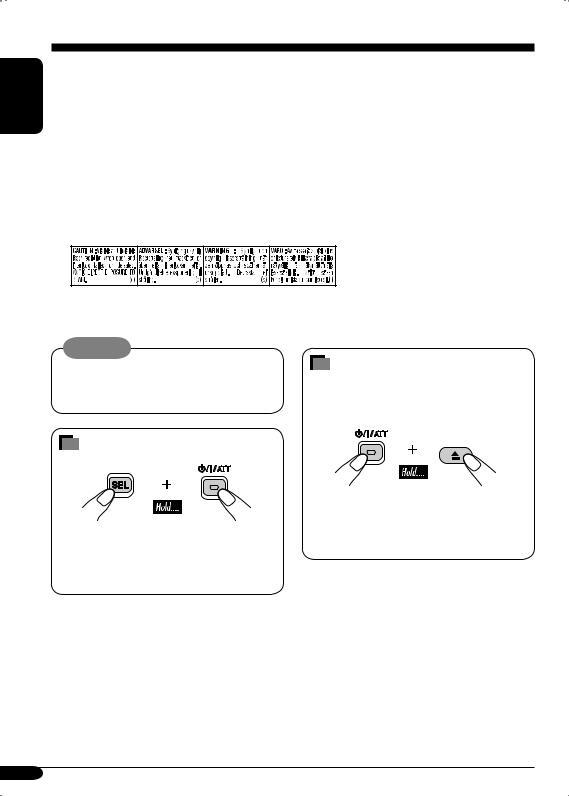
ENGLISH
Thank you for purchasing a JVC product.
Please read all instructions carefully before operation, to ensure your complete understanding and to obtain the best possible performance from the unit.
IMPORTANT FOR LASER PRODUCTS
1.CLASS 1 LASER PRODUCT
2.CAUTION: Do not open the top cover. There are no user serviceable parts inside the unit; leave all servicing to qualified service personnel.
3.CAUTION: Visible and invisible laser radiation when open and interlock failed or defeated. Avoid direct exposure to beam.
4.REPRODUCTION OF LABEL: CAUTION LABEL, PLACED OUTSIDE THE UNIT.
Warning:
If you need to operate the receiver while driving, be sure to look ahead carefully or you may be involved in a traffic accident.
How to forcibly eject a disc
If a disc cannot be recognized by the receiver or cannot be ejected, ejects the disc as follows.
How to reset your unit
•This will reset the microcomputer. Your preset adjustments will also be erased.
•If a disc is loaded, it will eject. Be careful not to drop the disc.
•If this does not work, try to reset your receiver.
•Be careful not to drop the disc when it ejects.
2

Contents
How to reset your unit ........................... |
2 |
How to forcibly eject a disc................... |
2 |
How to read this manual........................ |
4 |
How to use the MODE button ............... |
4 |
Control panel |
|
— KD-G416/KD-G415 ............... |
5 |
Parts identification................................. |
5 |
Remote controller — RM-RK50 ... |
6 |
Main elements and features ................... |
6 |
Getting started....................... |
7 |
Basic operations.................................. |
7 |
Canceling the display demonstrations ... |
8 |
Setting the clock .................................... |
8 |
Radio operations ................... |
9 |
Listening to the radio........................... |
9 |
Storing stations in memory.................... |
10 |
Listening to a preset station ................... |
11 |
Disc operations ...................... |
12 |
Playing a disc ..................................... |
12 |
Changing the display information ......... |
14 |
Selecting the playback modes................ |
15 |
Sound adjustments ................ |
16 |
Selecting preset sound modes |
|
(C-EQ: custom equalizer) .................. |
16 |
Adjusting the sound ............................... |
17 |
General settings — PSM ......... |
18 |
Basic procedure ..................................... |
18 |
Detaching the control panel.... |
19 |
Maintenance .......................... |
20 |
More about this receiver ........ |
21 |
Troubleshooting ..................... |
23 |
Specifications ......................... |
25 |
*For safety....
•Do not raise the volume level too much, as this will block outside sounds, making driving dangerous.
•Stop the car before performing any complicated operations.
*Temperature inside the car....
If you have parked the car for a long time in hot or cold weather, wait until the temperature in the car becomes normal before operating the unit.
ENGLISH
3
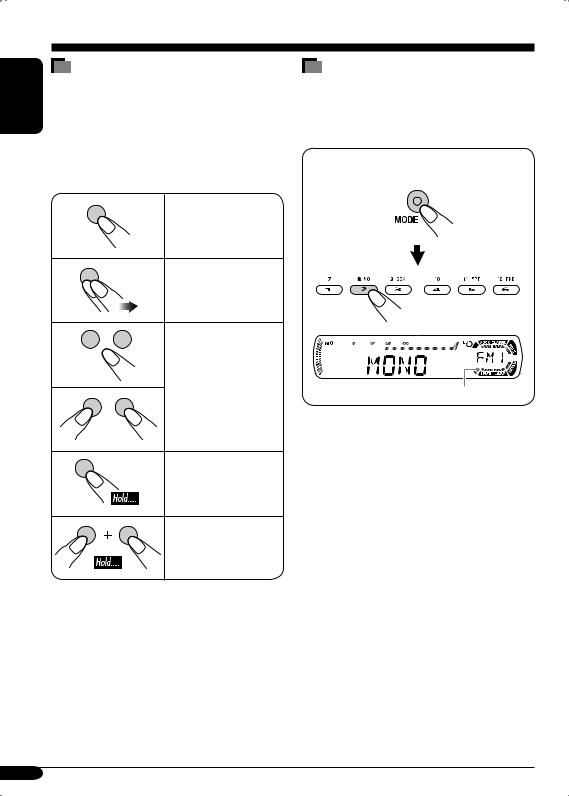
ENGLISH
How to read this manual
The following methods are used to made the explanations simple and easy-to-understand:
•Some related tips and notes are explained in “More about this receiver” (see pages 21 and 22).
•Button operations are mainly explained with the illustrations as follows:
Press briefly.
Press repeatedly.
How to use the MODE button
If you press MODE, the receiver goes into functions mode, then the number buttons and  ¢/4
¢/4  buttons work as different function buttons.
buttons work as different function buttons.
Ex.: When number button 2 works as MO (monaural) button.
Press either one.
Press and hold until your desired response begins.
Press and hold both buttons at the same time.
Time countdown indicator
To use these buttons for original functions again after pressing MODE, wait for
5 seconds without pressing any of these buttons until the functions mode is cleared.
•Pressing MODE again also clears the functions mode.
4
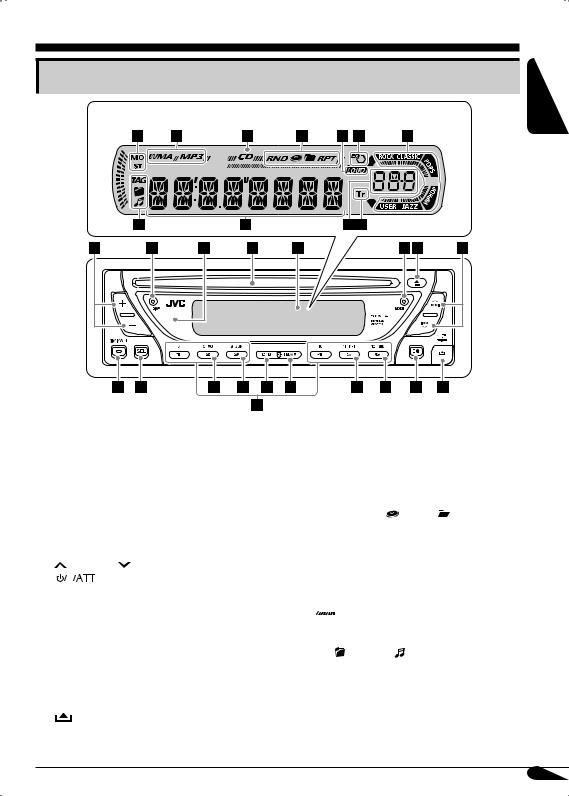
Control panel — KD-G416/KD-G415
Parts identification
Display window
ENGLISH
1 +/– buttons
2 DISP (display) button
3Remote sensor
•DO NOT expose the remote sensor to strong light (direct sunlight or artificial
|
lighting). |
|
4 |
Loading slot |
|
5 |
Display window |
|
6 |
MODE button |
|
7 |
0 (eject) button |
|
8 |
¢/4 buttons |
|
9 |
|
(standby/on/attenuator) button |
|
||
|
||
p SEL (select) button q MO (monaural) button
wSSM (Strong-station Sequential Memory) button
e CD button
r FM/AM button
t RPT (repeat) button y RND (random) button u EQ (equalizer) button
i (control panel release) button o Number buttons
Display window
;Tuner reception indicators— MO (monaural), ST (stereo)
a Disc type indicators—WMA, MP3 s CD indicator
d Playback mode / item indicators— RND (random), (disc), (folder), RPT (repeat)
f LOUD (loudness) indicator g EQ (equalizer) indicator
hSound mode (C-EQ: custom equalizer) indicators—ROCK, CLASSIC, POPS,
HIP HOP, JAZZ, USER
• also works as the time countdown indicator.
j Disc information indicators—TAG (ID3 Tag), (folder), (track/file)
k Main display
l Source display / Volume level indicator / Tr (track) indicator
5
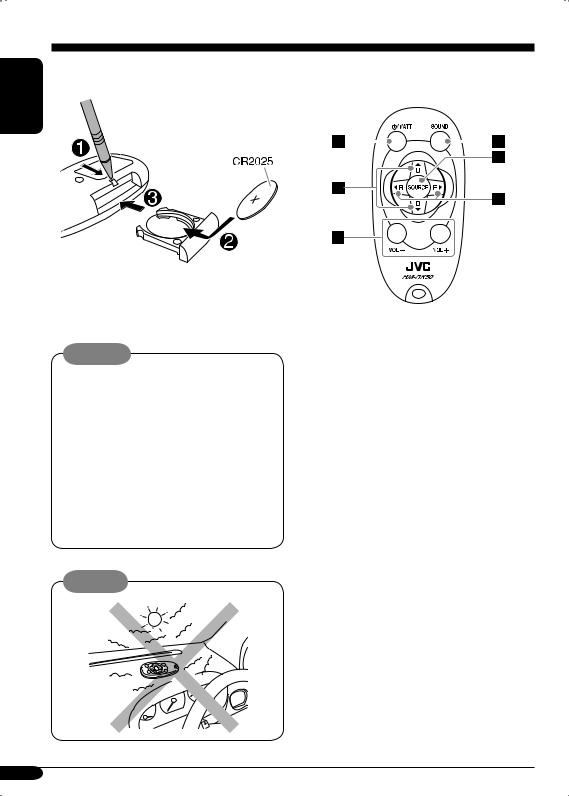
ENGLISH
Remote controller — RM-RK50
|
Installing the lithium coin battery |
Main elements and features |
||||
|
(CR2025) |
|||||
|
|
|
|
|
|
|
|
|
|
|
|
|
|
•When operating, aim the remote controller directly at the remote sensor on the receiver. Make sure there is no obstacle in between.
Warning:
•Store the battery in a place where children cannot reach to avoid risk of accident.
•To prevent the battery from over-heating, cracking, or starting a fire:
–Do not recharge, short, disassemble, or heat the battery or dispose of it in a fire.
–Do not leave the battery with other metallic materials.
–Do not poke the battery with tweezers or similar tools.
–Wrap the battery with tape and insulate when throwing away or saving it.
Caution:
1

 (standby/on/attenuator) button
(standby/on/attenuator) button
• Turns on and off the power and also
attenuates the sound.
25 U (up) / D (down) ∞ buttons
•5 U: Changes the FM/AM bands.
•D ∞: Changes the preset stations.
•Changes the folder of the MP3/WMA discs.
3VOL – / VOL + buttons
•Adjusts the volume level. 4 SOUND button
•Selects the sound mode (C-EQ: custom equalizer).
5SOURCE button
• Selects the source.
62 R (reverse) / F (forward) 3 buttons
•Searches for stations if pressed briefly.
•Fast-forwards or reverses the track if pressed and held.
•Changes the tracks of the disc.
6

Getting started
Basic operations
ENGLISH
~
Ÿ 
To drop the volume in a moment (ATT)
To restore the sound, press it again.
To turn off the power
You cannot select “CD” as the playback source if there is no disc in the loading slot.
!
Volume level appears.
Volume level indicator
⁄Adjust the sound as you want. (See pages 16 and 17.)
Caution on volume setting:
Discs produce very little noise compared with other sources. Lower the volume before playing a disc to avoid damaging the speakers by the sudden increase of the output level.
7
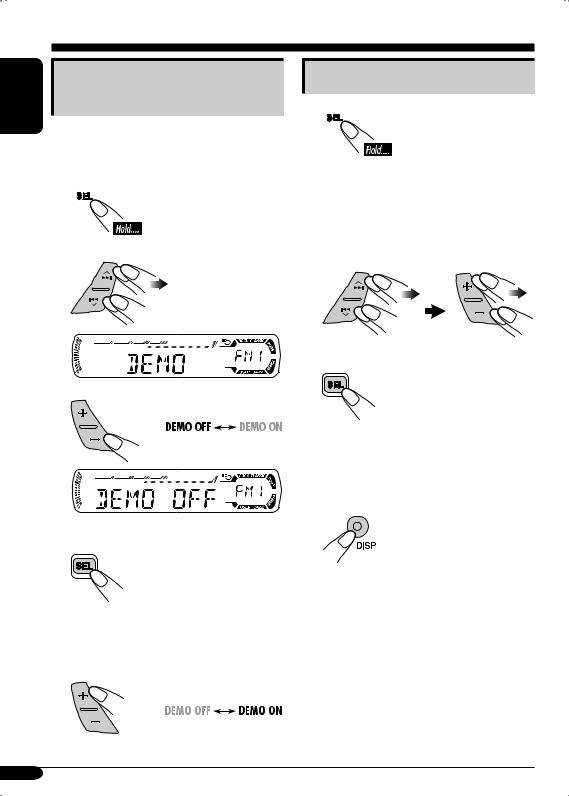
ENGLISH
Canceling the display demonstrations
If no operations are done for about 20 seconds, display demonstration starts.
[Initial: DEMO ON]—see page 18.
1 
2
3
Setting the clock
1
2Set the hour and minute.
1 Select “CLOCK H” (hour), then adjust the hour.
2Select “CLOCK M” (minute), then adjust the minute.
3 Finish the procedure.
To check the current clock time when the power is turned off
4 Finish the procedure.
To activate the display demonstration
In step 3 above...
8

Radio operations
Listening to the radio
ENGLISH
~ 











Lights up when receiving an FM stereo broadcast with sufficient signal strength.
Selected band appears.
ŸStart searching for a station.
When a station is received, searching stops.
To stop searching, press the same button again.
To tune in to a station manually
In step Ÿ on the left...
1
2 Select the desired station frequencies.
9
